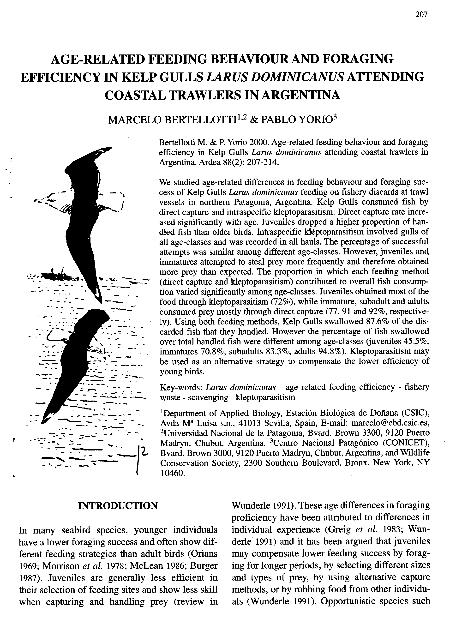Artículo
Age-related feeding behaviour and foraging efficiency in Kelp Gulls Larus dominicanus attending coastal trawlers in Argentina
Fecha de publicación:
12/2000
Editorial:
Netherlands Ornithologists' Union
Revista:
Ardea
ISSN:
0373-2266
e-ISSN:
2213-1175
Idioma:
Inglés
Tipo de recurso:
Artículo publicado
Clasificación temática:
Resumen
We studied age-related differences in feeding behaviour and foraging success of Kelp Gulls Larus dominicanus feeding on fishery discards at trawl vessels in northern Patagonia, Argentina. Kelp Gulls consumed fish by direct capture and intraspecific kleptoparasitism. Direct capture rate increased significantly with age. Juveniles dropped a higher proportion of handled fish than older birds. Intraspecific kleptoparasitism involved gulls of all age-classes and was recorded in all hauls. The percentage of successful attempts was similar among different age-classes. However, juveniles and immatures attempted to steal prey more frequently and therefore obtained more prey than expected. The proportion in which each feeding method (direct capture and kleptoparasitism) contributed to overall fish consumption varied significantly among age-classes. Juveniles obtained most of the food through kleptoparasitism (72%), while immature, subadult and adults consumed prey mostly through direct capture (77, 91 and 92%, respectively). Using both feeding methods, Kelp Gulls swallowed 87.6% of the discarded fish that they handled. However the percentage of fish swallowed over total handled fish were different among age-classes (juveniles: 45.5%; immatures: 70.8%; subadults: 83.3%; adults: 94.8%). Kleptoparasitism may be used as an alternative strategy to compensate the lower efficiency of young birds.
Archivos asociados
Licencia
Identificadores
Colecciones
Articulos(CCT-CENPAT)
Articulos de CTRO.CIENTIFICO TECNOL.CONICET - CENPAT
Articulos de CTRO.CIENTIFICO TECNOL.CONICET - CENPAT
Citación
Bertellotti, Néstor Marcelo; Yorio, Pablo Martin; Age-related feeding behaviour and foraging efficiency in Kelp Gulls Larus dominicanus attending coastal trawlers in Argentina; Netherlands Ornithologists' Union; Ardea; 88; 2; 12-2000; 207-214
Compartir




